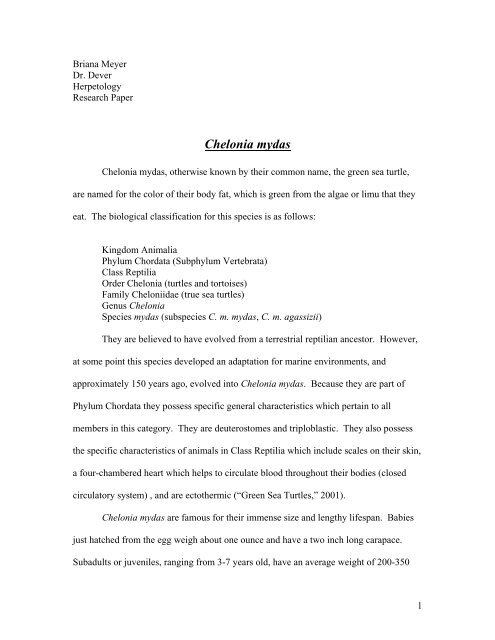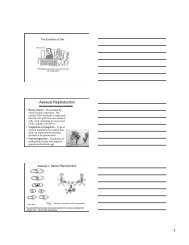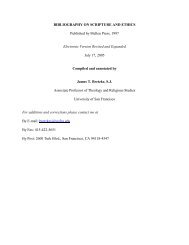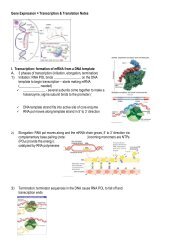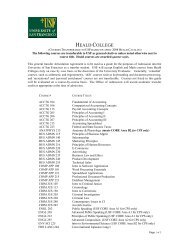Chelonia mydas - University of San Francisco
Chelonia mydas - University of San Francisco
Chelonia mydas - University of San Francisco
You also want an ePaper? Increase the reach of your titles
YUMPU automatically turns print PDFs into web optimized ePapers that Google loves.
Briana Meyer<br />
Dr. Dever<br />
Herpetology<br />
Research Paper<br />
<strong>Chelonia</strong> <strong>mydas</strong><br />
<strong>Chelonia</strong> <strong>mydas</strong>, otherwise known by their common name, the green sea turtle,<br />
are named for the color <strong>of</strong> their body fat, which is green from the algae or limu that they<br />
eat. The biological classification for this species is as follows:<br />
Kingdom Animalia<br />
Phylum Chordata (Subphylum Vertebrata)<br />
Class Reptilia<br />
Order <strong>Chelonia</strong> (turtles and tortoises)<br />
Family Cheloniidae (true sea turtles)<br />
Genus <strong>Chelonia</strong><br />
Species <strong>mydas</strong> (subspecies C. m. <strong>mydas</strong>, C. m. agassizii)<br />
They are believed to have evolved from a terrestrial reptilian ancestor. However,<br />
at some point this species developed an adaptation for marine environments, and<br />
approximately 150 years ago, evolved into <strong>Chelonia</strong> <strong>mydas</strong>. Because they are part <strong>of</strong><br />
Phylum Chordata they possess specific general characteristics which pertain to all<br />
members in this category. They are deuterostomes and triploblastic. They also possess<br />
the specific characteristics <strong>of</strong> animals in Class Reptilia which include scales on their skin,<br />
a four-chambered heart which helps to circulate blood throughout their bodies (closed<br />
circulatory system) , and are ectothermic (“Green Sea Turtles,” 2001).<br />
<strong>Chelonia</strong> <strong>mydas</strong> are famous for their immense size and lengthy lifespan. Babies<br />
just hatched from the egg weigh about one ounce and have a two inch long carapace.<br />
Subadults or juveniles, ranging from 3-7 years old, have an average weight <strong>of</strong> 200-350<br />
1
pounds with a shell length <strong>of</strong> at least two and a half feet long. Males are larger than<br />
females, but adults in general can weigh up to 400 pounds, have a shell as long as four<br />
feet, and can live up to 80 years <strong>of</strong> age (Jansen, 2003).<br />
In the following pages I would like to discuss specifics pertaining to the habitat<br />
range and distribution <strong>of</strong> the green sea turtle, its feeding practices, physical adaptive<br />
features which help to protect them from predation and other elements in their<br />
environment, and reproductive and mating behaviors practiced. Lastly, however most<br />
importantly, I will investigate several factors which are currently effecting the population<br />
<strong>of</strong> the green sea turtle, all contributing to the endangered status <strong>of</strong> this species.<br />
Distribution<br />
Populations <strong>of</strong> the <strong>Chelonia</strong> <strong>mydas</strong> can be found worldwide in warmer waters<br />
with a temperature above 20 degrees Celsius. This includes the United States, <strong>of</strong>f the<br />
east and west coasts <strong>of</strong> Florida, the Caribbean, <strong>of</strong>f the Pacific coast <strong>of</strong> Mexico, and other<br />
tropical marine climates. There is also a large population <strong>of</strong>f the coasts <strong>of</strong> the main<br />
Hawaiian Islands which provide all the essential nutrients needed for this species diet as<br />
well as several popular nesting sites (Jansen, 2003).<br />
Feeding<br />
Adult green sea turtles are herbivores, therefore they possess certain bacterial<br />
microbes in their guts to aid in the digestion <strong>of</strong> plant material, such as seaweed and algae.<br />
Juvenile green sea turtles are omnivorous, feeding <strong>of</strong>f <strong>of</strong> plankton, jellyfish and other<br />
invertebrates that may be found in their marine habitat (“Green Sea Turtles,” 2001).<br />
However, like many other species, the green sea turtle may have to make slight<br />
adjustments to the types <strong>of</strong> organisms they feed <strong>of</strong>f <strong>of</strong> as well as feeding locations, due to<br />
2
changing environmental conditions and other possible interfering factors. Research<br />
performed in the Ogasawara Islands <strong>of</strong>f the coast <strong>of</strong> Japan gathered data using satellite<br />
telemetry and stable isotope analysis to investigate possible alternative feeding habitats <strong>of</strong><br />
<strong>Chelonia</strong> <strong>mydas</strong>. Results show that aside from the typical neritic areas (water depths<br />
reach less than 200 meters) where we expect to find sea turtle feeding activity, this<br />
species has also adopted an alternate oceanic feeding habitat where water depths will<br />
<strong>of</strong>ten exceed 200 meters (Hatase et al, 2006). This study shows the necessity for a<br />
species to be slightly flexible in adapting to current changes in their habitats. This will<br />
help to increase their likelihood <strong>of</strong> survival.<br />
Adaptive Features<br />
Due to the marine habitat <strong>of</strong> the <strong>Chelonia</strong> <strong>mydas</strong> they are constantly faced with<br />
many potentially harmful obstacles, such as predation from other carnivorous animals<br />
and pollution <strong>of</strong> their environment. In order to protect themselves the <strong>Chelonia</strong> <strong>mydas</strong>,<br />
like many other species, have specific, physical adaptive features to ensure a better<br />
chance <strong>of</strong> survival.<br />
All species <strong>of</strong> turtles have evolved a bony outer shell to protect themselves from<br />
predators. This is known to be the most highly developed protective armor <strong>of</strong> all<br />
vertebrates. However, the <strong>Chelonia</strong> <strong>mydas</strong> has a further adaptation to their shell.<br />
Because <strong>of</strong> their marine habitat they are constantly in water and must travel long<br />
distances and stay afloat, therefore the shell <strong>of</strong> the sea turtle actually weighs less and is<br />
more streamlined than that <strong>of</strong> a terrestrial turtle, which makes traveling through water<br />
much easier. All four <strong>of</strong> their limbs (front and rear) have evolved into flippers, making<br />
them very efficient swimmers, covering long distances in short periods <strong>of</strong> time. Sea<br />
3
turtles have been known to move through the water as fast as 35 mph. Also, sea turtles<br />
are capable <strong>of</strong> containing higher concentrations <strong>of</strong> carbon dioxide in their blood<br />
compared to other animals. Therefore they can use the oxygen they consume more<br />
efficiently. They are able to store oxygen in their blood as well as in their muscles, in<br />
large quantities. They will usually swim to the surface to breathe every few minutes,<br />
however when sleeping they can go for as long as two hours before having to take a<br />
breath (“Green Sea Turtles,” 2001).<br />
Another adaptation to their environment would be the salt gland they have, one<br />
located behind each eye. In order to maintain homeostasis, their controlled internal<br />
environment, they must somehow excrete all the excess salts they are taking in from the<br />
salt water in which they live. The salt gland helps them to excrete salt in the form <strong>of</strong> a<br />
“tear” from their eyes. This helps to maintain the salt levels in their blood (“Green Sea<br />
Turtles,” 2001).<br />
Reproductive and Development<br />
<strong>Chelonia</strong> <strong>mydas</strong> have very specific and unique mating practices. They are an<br />
oviparous species, meaning they reproduce by laying eggs. However, because they<br />
develop at such a slow rate (taking approximately 25 years to reach sexual maturity) they<br />
do not begin to reproduce until they are adults. Once they have reached adulthood and<br />
fully matured they are able to reproduce. Typically, mating will begin in March and<br />
occurs in waters adjacent to the nesting beaches where the females will eventually lay<br />
eggs. Adults must first migrate to these nesting beaches from their foraging grounds,<br />
which can <strong>of</strong>ten be a long voyage. Males will make this trip every year, while females<br />
4
only have to migrate every 2-4 years. Once near these grounds fertilization occurs<br />
internally (Broderick, Godly, & Hays, 2001).<br />
Next, nesting will occur from late April to September. Nesting occurs at night<br />
and the female must come ashore to lay her eggs on the beaches. This may occur as<br />
many as five times at 11 to 18 day intervals. However, researchers at Kyoto <strong>University</strong> in<br />
Japan have discovered that in areas where tropical climates allow for the sand<br />
temperature to remain within the thermal tolerance range (TTR), optimal temperature for<br />
egg incubation, mating practices will proceed year round. This suggests behavioral<br />
evolution <strong>of</strong> the species <strong>Chelonia</strong> <strong>mydas</strong>, for they will nest during periods when the sand<br />
temperature is most favorable, avoiding the months when nest temperatures could<br />
possibly drop below the TTR (Yasuda et. al, 2006).<br />
The female will find a safe place and dig a pit in the sand to deposit a bundle <strong>of</strong><br />
100-120 ping-pong ball sized eggs before gently covering up the hole with her flippers to<br />
protect the eggs from the external environment. According to Annette Broderick, head <strong>of</strong><br />
the Marine Turtle Research Group at the <strong>University</strong> <strong>of</strong> Wales, as stated in the Journal <strong>of</strong><br />
Physiological and Biochemical Zoology, “In all nest-building species the placements,<br />
both temporally and spatially, <strong>of</strong> a clutch [<strong>of</strong> eggs] is crucial to the survival <strong>of</strong> the<br />
<strong>of</strong>fspring, especially in oviparous species” (Broderick et. al, 2001). The location <strong>of</strong> the<br />
nest is essential to the survivorship <strong>of</strong> the green sea turtle. If the female does not take<br />
care to find a secure place to lay her eggs there is little chance that the eggs would<br />
survive a two month incubation period. Some extra conscience females have even been<br />
known to dig “decoy” nests near the real nest in hopes <strong>of</strong> tricking predators and<br />
distracting them from the true nest sight (Broderick et. al, 2001).<br />
5
After making sure the nest is securely covered with sand the mother will return to<br />
the water leaving the eggs to incubate for approximately two months before they hatch.<br />
The little hatchlings will then use a structure called the egg tooth, which is a protrusion<br />
from their beaks, to dig their way out <strong>of</strong> the nest, in a group effort. Once free, they must<br />
find their way safely to the shore without any parental care and forage for food in the<br />
ocean.<br />
There are many theories as to how the hatchlings determine whether it is safe to<br />
emerge from the nesting site. An article published in the Journal <strong>of</strong> Experimental Marine<br />
Biology and Ecology investigates potential stimuli. After collecting and analyzing their<br />
data from two separate beaches on Ascension Island in the South Atlantic, researchers<br />
concluded that a change in the temperature <strong>of</strong> the sand would indeed have an effect on<br />
the temporal pattern <strong>of</strong> hatchling emergence. It is very important for hatchlings to be<br />
able to detect this drop in temperature, which is indicative <strong>of</strong> nighttime. This provides the<br />
best opportunity for hatchlings to forage across the beaches to the water, hopefully<br />
avoiding predation (Glen et. al, 2006).<br />
Once in the water, being able to locate and eat prey is essential to the survival <strong>of</strong><br />
these vulnerable young. Research shows that the incubation temperature has been proven<br />
to have an affect on the body size and swimming capabilities <strong>of</strong> the hatchlings. Thus,<br />
some are more likely than others to succeed in feeding and escaping predators. A report<br />
in Coral Reefs states that eggs incubated at 26 degrees Celsius produced hatchlings that<br />
were larger in size than hatchlings from eggs that were incubated at 28 and 30 degrees<br />
Celsius. Also, hatchlings from eggs incubated at 26 degrees Celsius had a lower stroke<br />
rate frequency and lower force output than those incubated at 28-30 degrees Celsius.<br />
6
From this data researchers were able to conclude that hatchlings that were incubated at<br />
cooler temperature’s experienced muscle fatigue at a faster rate. This experiment further<br />
proves the paramount role temperature plays in the survival <strong>of</strong> the <strong>of</strong>fspring <strong>of</strong> this<br />
species. If the <strong>of</strong>fspring cannot survive to full development, there is a good chance the<br />
species will eventually become extinct (Burgess et al, 2006).<br />
Factors Affecting <strong>Chelonia</strong> <strong>mydas</strong> Populations<br />
The green sea turtle has been classified as endangered on the IUCN Red list <strong>of</strong><br />
threatened species since 1982, meaning that this species is on a trajectory towards<br />
extinction and drastic measures need to be taken to protect <strong>Chelonia</strong> <strong>mydas</strong> populations.<br />
There were once several million however, today there are less than 200,000 reproducing<br />
female green sea turtles in Hawaii. Also, scientists have estimated as few as 100 to 350<br />
nesting females. The nesting female population on Aves Island <strong>of</strong> the coast <strong>of</strong> Venezuela<br />
has declined by more than 90% since 1879 (Broderick et. al, 2006). This massive<br />
decline in populations <strong>of</strong> green sea turtles can be attributed to several factors such as<br />
commercial over-harvesting for eggs and food, fisheries by-catch, dredging, collision<br />
with boats, loss <strong>of</strong> nesting sites, ingestion <strong>of</strong> marine debris, and pollution. A few specific<br />
examples are discussed below (Lam et. al, 2006).<br />
Hunting <strong>of</strong> the <strong>Chelonia</strong> <strong>mydas</strong> is one <strong>of</strong> the initial reasons they became<br />
endangered. Before the federal government passed the Endangered Species Act <strong>of</strong> 1973,<br />
green sea turtles were killed in large numbers to feed fishing crews and to provide meat<br />
for restaurants in the Northwestern Hawaiian Islands, causing a large decrease in their<br />
population. They are also hunted for their shells to make jewelry, their skin is harvested<br />
to make small leather goods, their fat for oil, and even their eggs and meat pose as<br />
7
traditional meals in some Southeast Asian countries. Also, because <strong>of</strong> their predictable<br />
nesting patterns and their vulnerability once on land, it is easy for poachers to hunt them<br />
and make a pr<strong>of</strong>it, despite the laws prohibiting these actions (Toeeng & Rankin, 2005).<br />
Predation has also become a problem for this species. Scavengers will destroy<br />
nests and eat the eggs along beaches. Young hatchlings are very vulnerable to attack by<br />
predators as well as environmental elements once they have surfaced above the sand. A<br />
study done on Jupiter Island <strong>of</strong>f the east coast <strong>of</strong> Florida by Hobe Sound National<br />
Wildlife Refuge (HSNWR) showed that by removing primary predators, such as<br />
armadillos and raccoons, from nesting sites, <strong>of</strong>fspring managed to safely hatch and travel<br />
to the nearby ocean for feeding. By 2002 predation was reduced to less than 10% at this<br />
site. Unfortunately, funding for the project ran out by 2004, and with only two months <strong>of</strong><br />
the hatching period to go, predation surged back in even greater numbers, wiping out a<br />
great portion <strong>of</strong> the <strong>Chelonia</strong> <strong>mydas</strong> <strong>of</strong>fspring population (Engeman, R. et al, 2006).<br />
Another factor affecting the green sea turtle population is pollution. Litter and<br />
other debris can be especially harmful because the turtles can get entangled in this<br />
material or may mistake it for food and ingest it. Plastics are <strong>of</strong>ten a problem because<br />
they are very abundant amongst litter and are difficult to digest. These materials could<br />
block the passage way for ingestion preventing them from eating. If ingestion is<br />
successful, once digested, these foreign materials may turn out to be harmful, releasing<br />
toxic chemicals in the turtles gut during digestion (“Green Sea Turtles,” 2001).<br />
An article published in Environmental Pollution discusses the results <strong>of</strong> a study<br />
investigating the exposure <strong>of</strong> green sea turtles to certain harmful contaminants in their<br />
environment. After collecting egg samples from islands <strong>of</strong>f the coasts <strong>of</strong> Hong Kong<br />
8
esearchers discovered many widely used synthetic chemicals, including polychlorinated<br />
biphenyls (PCBs), and organochlorine pesticides (OCPs). Due to the long lifespan <strong>of</strong><br />
<strong>Chelonia</strong> <strong>mydas</strong>, and their migratory practices, they are at great risk <strong>of</strong> being exposed to<br />
many <strong>of</strong> these toxic and <strong>of</strong>ten when accumulated in large quantities, deadly, chemicals.<br />
This is why it is so important for humans to be aware <strong>of</strong> the waste they produce. Much <strong>of</strong><br />
the by-product resulting from human activity is disposed <strong>of</strong> in another species habitat and<br />
will <strong>of</strong>ten cause harm (Lam et. al, 2006).<br />
Coastal development and habitat degradation are also main reasons endangering<br />
the green sea turtle population. Nesting beaches are transformed each year due to coastal<br />
development. Noise, lights and beach obstructions are disruptive and can make usually<br />
safe nesting areas unfamiliar and dangerous to females when they are trying to lay their<br />
eggs (Troeeng & Rankin, 2005).<br />
Lastly, a disease known as fibropapilloma has had a negative effect on the<br />
<strong>Chelonia</strong> <strong>mydas</strong> population. This disease has been discovered in Hawaii’s green sea<br />
turtle population as well as <strong>of</strong>f the coast <strong>of</strong> Florida. Fibropapilloma causes large tumors<br />
to develop on the turtle’s s<strong>of</strong>t tissue. These tumors will <strong>of</strong>ten spread to other parts <strong>of</strong> the<br />
body and will ultimately end up killing the infected turtle. The cause <strong>of</strong> this disease is<br />
currently unknown, however scientists suspect that a virus, parasite or perhaps the effects<br />
<strong>of</strong> marine pollution could be associated with development <strong>of</strong> fibropapilloma (Troeeng &<br />
Rankin, 2005).<br />
Discussion<br />
Due to the length <strong>of</strong> time it takes for the <strong>Chelonia</strong> <strong>mydas</strong> to reach sexual maturity<br />
(approximately 25 years) it takes them many years to recover from substantial population<br />
9
declines. This is why actions need to be taken to ensure that this species does not become<br />
extinct. Currently the green sea turtle is fully protected by the federal Endangered<br />
Species Act and by Hawaiian state law. These laws prohibit hunting, injuring or<br />
harassing them, as well as holding them in captivity without obtaining a special permit<br />
for research or educational purposes. Fines will also be placed on swimmers and divers if<br />
they attempt to ride on the back <strong>of</strong> a green sea turtle because it will put them under<br />
unnecessary stress. These fines can be as high as $100,000 (Hays et al., 2002).<br />
Also, a recovery team has recently been formed to help restore the Hawaii’s green<br />
sea turtle population. To ensure the survival <strong>of</strong> this species it is important that laws are<br />
obeyed and their habitat is respected. Without the consideration and awareness <strong>of</strong> the<br />
public, the chances <strong>of</strong> survival <strong>of</strong> the <strong>Chelonia</strong> <strong>mydas</strong> are minimal.<br />
10
References<br />
Broderick, A., Godly, B., & Hays, G. 2001. Metabolic heating and the prediction <strong>of</strong> sex<br />
ratios for green turtles (<strong>Chelonia</strong> <strong>mydas</strong>). Physiological and Biochemical Zoology,<br />
74(2): 161-170.<br />
Broderick, A. et al. 2006. Are green turtles globally endangered? Global Ecology and<br />
Biogeography, 15: 21-26.<br />
Burgess, E., Booth, D., Lanyon, J. 2006. Swimming performance <strong>of</strong> hatchling green<br />
turtles is affected by incubation temperature. Coral Reefs, 25: 341-349.<br />
Earthtrust. 2001. Green sea turtles. Retrieved November 8, 2006, from website:<br />
http://www.earthtrust.org/wlcurric/turtles.html<br />
Engeman R., et al. 2006. Impact on predation <strong>of</strong> sea turtle nests when predator control<br />
was removed midway through the nesting season. Wildlife Research, 33: 187-192.<br />
Glen, F. et al. 2006. Thermal control <strong>of</strong> hatchlings emergence patterns in marine turtles.<br />
Journal <strong>of</strong> Experimental Marine Biology and Ecology, 334: 31-42.<br />
Hatase, H. et al. 2006. Individual variation in feeding habitat use by adult female green<br />
sea turtles (<strong>Chelonia</strong> <strong>mydas</strong>): are they obligately neritic herbivores? Population<br />
Ecology, 149: 52-64.<br />
Hays, G. 2002. The case <strong>of</strong> the green turtle (<strong>Chelonia</strong> <strong>mydas</strong>) at Ascension Island.<br />
Canadian Journal <strong>of</strong> Zoology, 80: 3-5.<br />
Jansen, Katherine. 2003. Green sea turtle. Retrieved November 8, 2006, from the<br />
<strong>University</strong> <strong>of</strong> <strong>San</strong> <strong>Francisco</strong> Library:<br />
http://proquest.umi.com.ignacio.usfca.edu/pqdwebindex.htm<br />
11
Lam, J., et al. 2006. Levels <strong>of</strong> trace elements in green turtle eggs collected from Hong<br />
Kong. Environmental Pollution, 144: 790-801.<br />
Troeeng, S. 2005. Long-term conservation efforts contribute to positive green turtle<br />
<strong>Chelonia</strong> <strong>mydas</strong> nesting trend. Biological Conservation, 121: 35-37.<br />
Yasuda, T., et al. 2006. Do female green turtles (<strong>Chelonia</strong> <strong>mydas</strong>) exhibit reproductive<br />
seasonality in a year-round nesting rookery? Journal <strong>of</strong> Zoology, 269: 451-457.<br />
12


